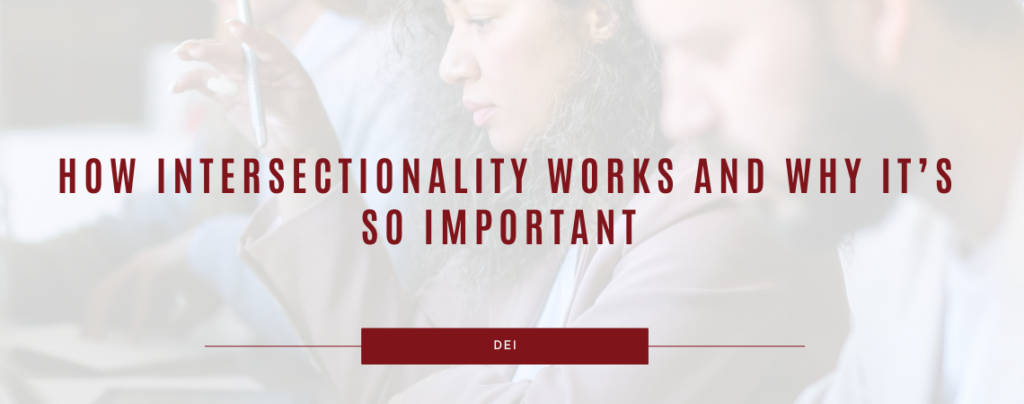
When we talk about workplace inclusion, we often focus on single identities - gender, race, disability. But in reality, people don’t experience the world through just one lens.
That’s where intersectionality comes in.
What is Intersectionality?
The term intersectionality was coined by legal scholar Kimberlé Crenshaw in 1989 to highlight how Black women face overlapping forms of discrimination that can't be fully understood by looking at race or gender alone.
While the concept may sound a bit complex, it’s simply about recognizing that each person is made up of many different identities that can shape their unique experiences, such as race, gender, and sexual orientation.
Naturally, these identities overlap. Different parts of who we are come together and influence our life experiences. These different identities need to be considered together to better understand the experiences and challenges that people face.
For example, a Black woman may face challenges that are different from those faced by a white woman or a Black man. These overlapping identities can lead to unique experiences of both privilege and discrimination.
Why is Intersectionality Important in the Workplace?
Intersectionality is essential in DEI efforts because it helps organizations move beyond a one-size-fits-all approach and create more inclusive, nuanced solutions that address the real needs of diverse individuals.
Essentially, when we apply an intersectional lens to our workplace, we start to see things we might have missed the first time.
Here’s why it’s so important:
- It helps us see the whole person.
Each of us is shaped by many different factors, from our background to our personal environments. When we only focus on one part of someone’s identity, we can miss a lot. Understanding intersectionality allows us to see the full picture, which leads to a more thoughtful and empathetic workplace. - It leads to real inclusion.
If we want to create an environment where everyone feels truly included, we need to think about how different aspects of identity interact. For example, an employee who is both 2SLGBTQIA+ and a person of colour might experience different challenges than someone who is straight or white. Without an intersectional approach, our inclusion efforts might unintentionally overlook these differences. - It improves well-being and engagement.
When people feel seen and understood for who they truly are, they’re more likely to feel comfortable, valued, and motivated in their roles. This leads to higher job satisfaction, better mental health, and a stronger sense of belonging at work. - It fuels innovation.
A diverse team, where everyone feels they belong and can bring their whole selves to work, is a team that’s more creative and innovative. Recognizing intersectionality means we’re encouraging different perspectives and experiences, which ultimately leads to better problem-solving and new ideas.
How can employers create a culture of belonging?
Building a workplace that truly values everyone, regardless of their intersecting identities, requires some thoughtful and intentional actions.
Here are 4 practical ways you can foster a more inclusive environment:
- Encourage open conversations.
Creating a space where employees feel safe to share their experiences is key. This helps us understand how different identities can overlap and influence someone’s experience at work. Start by encouraging open dialogue around identity and inclusivity, this can be done through informal discussions or dedicated sessions. - Train your leaders to recognize intersectionality.
Leaders play a huge role in shaping workplace culture. When leaders are trained to understand intersectionality, they can be more empathetic and proactive in supporting their teams. This training should help them recognize that the experiences of their employees aren’t one-size-fits-all and that people’s identities can affect their experiences at work in different ways. - Create supportive employee resource groups.
Employee resource groups (ERGs) are an excellent way to provide support to employees who share similar identities or experiences. But it’s important to make sure these groups are open and inclusive of intersecting identities. This ensures that no one feels left out or isolated. - Regularly gather feedback.
To truly understand how inclusive your workplace is, it’s essential to gather feedback from your employees. This can be done through surveys, informal check-ins, focus groups or even through fostering a culture that values open dialog. By regularly asking for input, you can identify any gaps and adjust your approach to be more inclusive.
Practical Ways to Apply an Intersectional Lens at Work
- Start by recognizing the full scope of identity. When designing policies, practices, or programs, think beyond one aspect of identity (like gender or race) and consider the different ways people’s identities intersect.
- Keep learning. Help employees at all levels understand what intersectionality is and how it affects everyone differently. Regular training and education can make these ideas more accessible and create a more empathetic workplace.
- Foster allyship. Encourage employees to support one another, especially those who may be facing multiple forms of discrimination or bias. Allyship can go a long way in helping people feel included and valued.
- Hold yourself accountable. It’s easy to say that we want an inclusive workplace but making it a reality takes consistent effort. Make sure to regularly assess your progress and be open to making changes if something isn’t working.
Ready to Create a Culture of Belonging in Your Workplace?
Understanding intersectionality is a powerful step toward building a truly inclusive workplace—but knowing where to start can feel overwhelming. How do you create policies and practices that recognize the full scope of identity and lived experiences?
That’s where we come in. Our team helps organizations move from good intentions to real impact, guiding you in building a workplace where every employee feels seen, heard, and valued.
Let’s connect and take the first step together.
Prefer to get started on your own? Click here to download our free DEI Checklist and pinpoint areas of opportunity where you can make a bigger impact.